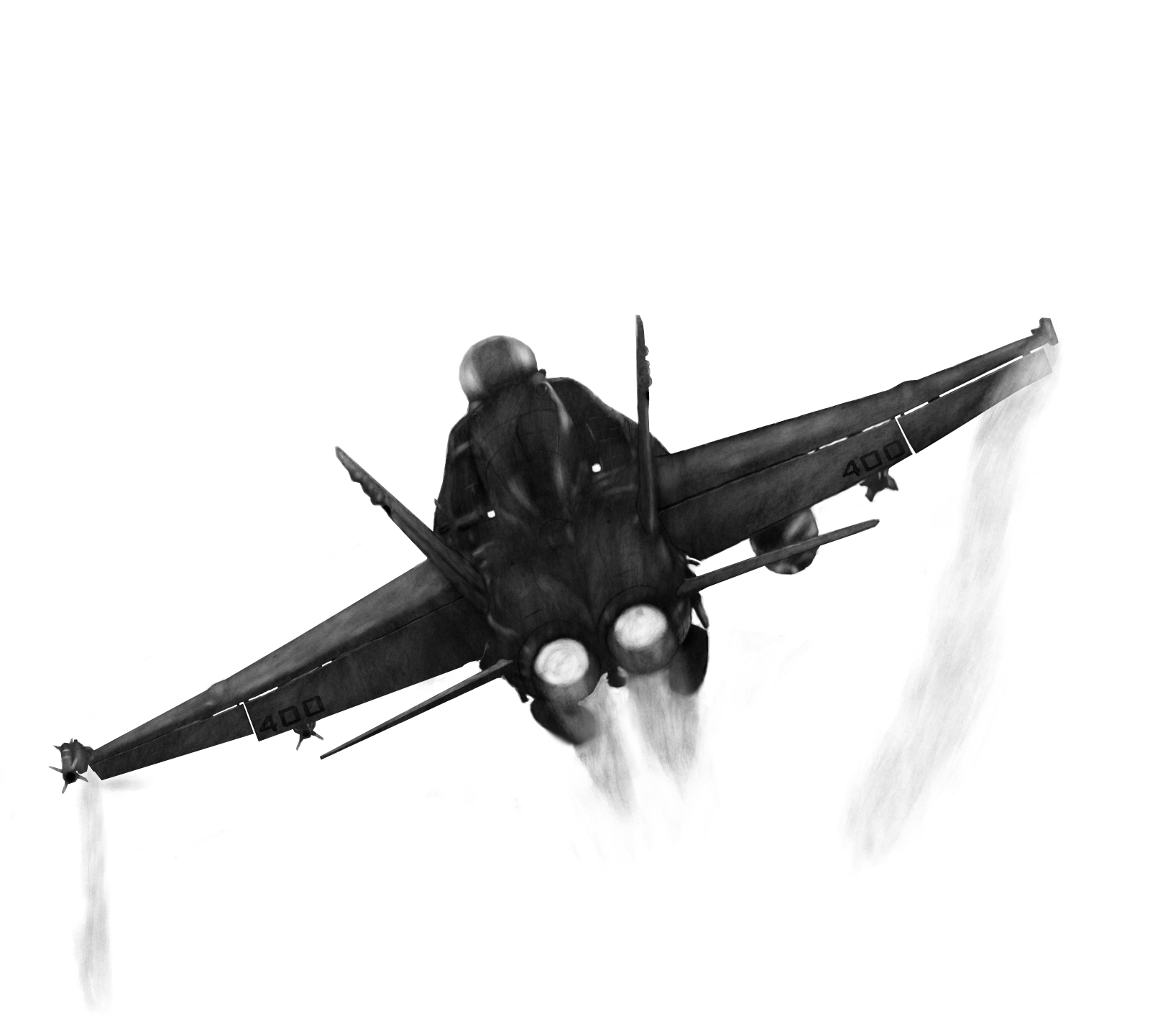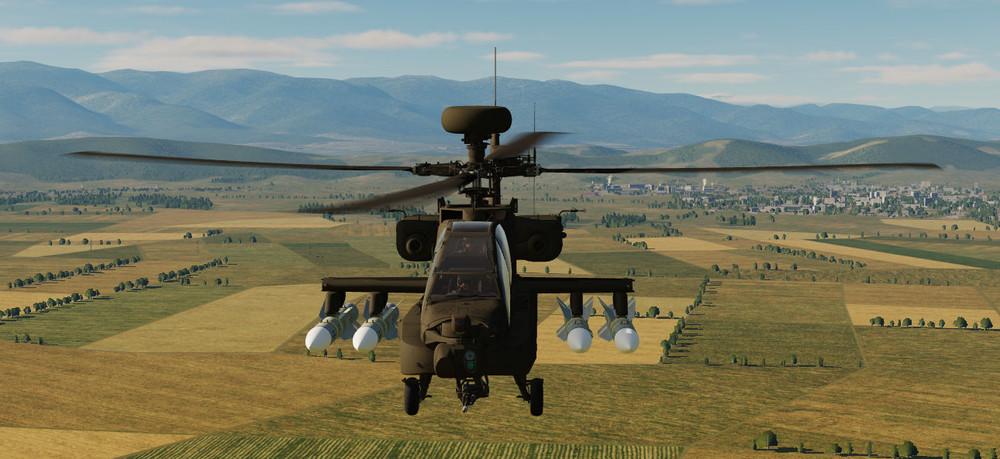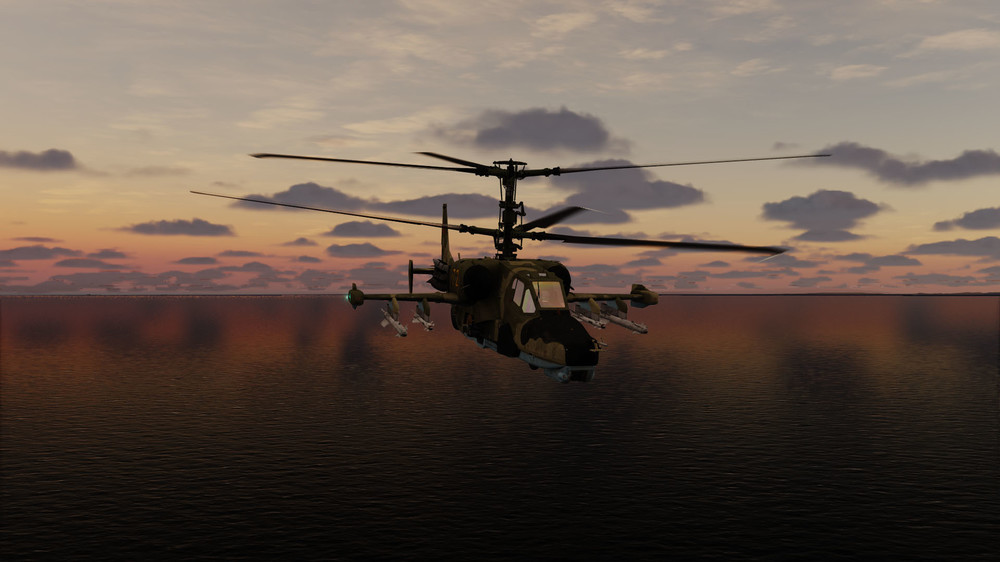-
Posts
703 -
Joined
-
Last visited
Content Type
Profiles
Forums
Events
Everything posted by NeedzWD40
-
In the sim, if you use either coop rockets or a fixed target point, aiming at the target point only gets you decent accuracy within 4.5km. As you get further away, rockets always fall short, as it seems the ballistic calculations only go out to 4500m. If you manually aim the rockets at a fixed point by using your head to aim above the target, the rockets will connect (although dispersion will be greater of course). This is in contrary to the real thing, which is supposed to calculate out to 7.5km for the Mk66 motor and 9km for the CRV-7 motor. That is to say, if your target is within 7.5km and you either have good laser ranging for coop or a good target position, the computers should properly elevate the pylons to hit the target out to that distance without you having to elevate your head or modify your aim point.
-
Currently, it seems the ballistic calculations only go out to ~4.5km, even though they should go out to 7.5km for Mk66 and >9km for CRV-7. My solution has been to create a target point and manually aim at that target point rather than rely on coop rockets, that way I can elevate the pylons more appropriately. It's like playing battleship at first but eventually you can make some sweet long range hits. Illumination are supposed to burst at about 3.5km downrange by default, so I would use the above manual strategy to aim above the target area and when within 4km, fire rockets.
-
Hot starts default to the hover mode; select the transition mode and you'll get the fly-to path back.
-
Regular US Army units have done it and long before the RAF ever did. There was at least one case in Desert Storm and multiple cases in the past 20 years during OIF and OEF. https://www.myplainview.com/news/article/Apache-pilot-recommended-for-medal-after-rescuing-8921053.php https://www.nationalguard.mil/News/Article-View/Article/573012/apache-pilots-save-critically-wounded-soldier-with-unorthodox-evacuation/
-
That was exactly it! Moved them into the appropriate section and it is functioning properly.
-

reported Mi-8 - What are they made of
NeedzWD40 replied to Toni Carrera's topic in Bugs and Problems
This problem affects every AI helicopter; the only way to absolutely wipe them off the map is with a direct heavy weapon hit like a 500lb bomb. Anything less will just catastrophically damage them. I hit a Gazelle the other day with 20mm in the cockpit and cut the tail off; it dropped to the top of a building and bounced, then the pilot got out as the engine spun down. -
For me, it doesn't work in the joystick section, but it does work in the keyboard section.
-
Yes, it can be used that way. George does not properly utilize LOAL modes yet. There are situations where the pilot may be set to fire at a pre-planned point, ie defilade fire, where they will need to set acquisition sources and engage independently or in tandem with the CPG. The crew are intended to be fluid as the situation dictates. You can leverage higher trajectories and get additional range and/or angles on a target. To use George in an LOAL bobup context, you'll have to take control of the HELLFIRE yourself and set a point up as your acquisition source. You can either direct George to find a target and drop a point where he's looking via the TSD or you can pipe in coordinates via the KU. Once this is done and you have your point set as your acquisition source, get within firing parameters, fire, then wait til your missile TOF is within ~15 seconds of impact. Bob up, direct George to search, find your appropriate target, tell him to track it. If you've done it right, the missile will acquire in the terminal and hit. This is convoluted, but it's the only workaround at the moment without buddy lasing or a human CPG.
-
What are the friendly assets available? Fixed wing platforms? Terrain? 8xAT-9 + 40xS-8KOM is my choice for such targets. On flat desert, high speed, low altitude runs with ATGM from max distance, prioritizing missile carriers first. Rough terrain gives a few more options depending on the situation and hover fires from cover might be preferable; you can loft rockets in or peek out from covered positions for ATGM launches. Much of this can vary depending on the situation, but since you have a group I'd work with them to isolate threats and provide mutual support. It'd really help to know more about the situation(s) though.
-
Yes, the I-beam isn't CCIP; it's intended to be used as an indicator for how much elevation you have available for your pylons. So if your sight is at the top of the I-beam, you have little/no remaining positive elevation, while if at the bottom then you have little negative elevation available.
-
All but your first three images are of Block I aircraft. Note the disco ball, old PNVS, lack of CMWS, etc. Further, the ASPI exhausts aren't easier to install/remove than the FCR. ASPI is a near-permanent modification to the aircraft, not a bolt on/off option like the Mi-24/Mi-8 exhaust diffusers. Having said that, there are examples of aircraft having all the fixings outside of ASPI: There were even AH-64A aircraft that had CMWS installed: https://www.airliners.net/photo/USA-Army/McDonnell-Douglas-AH-64A-Apache/1545592/L There's a lot of possible configurations out there depending on unit, date, and deployment.
-
It affects where the pylons are elevating to hit, thus making it a bit easier to adjust your fire. If your target is at 4km and you set your range to 4km, then adjustments with your aim point are minor instead of major. Try it: set your range to 500m and attempt to manually aim at a target at 3km away. You have to elevate your head a great deal to make up that range. The problem with the automatic mode is it's generally unreliable due to being dependent on radar altimeter and angles. What might look like a small change in range from your viewpoint can easily be misconstrued as an extreme change by the automatic mode. From higher altitudes and flatter ground it might be adequate, but if you're spending a lot of time down in the weeds you'll want a more reliable ranging source. As another example, it also adds difficulty when attempting to fire indirectly over obstacles.
-
Basically, if using HMD as a sight: where you look is where the system tries to aim the rockets, no matter the ranging source. Your I-beam needs to be lined up with the HMD crosshairs for azimuth, but you will have to fire-adjust-fire in elevation to get rockets on target. If rockets hit too short, then adjust your head above the target; if too long, then adjust down. Think of the ranging source as a weapon zero, not your actual aim point.
-
Picking nits, but: The first standardized US Army Cobra with the M197 would've been the AH-1E. The AH-1Q introduced the HSS, TSU, and TOW capability. The G model has some variations as well, such as the tail rotor placement, landing light placement, M28 turret (first variants had only single minigun/grenade launcher), and other superficial differences. That out of the way, I would do an AH-1J first. This could be the first USMC variations, followed by the variations made for Iran (different pantographic sight, some variations in cooling intakes). The International version in particular would offer HSS, TSU, and TOW capability on an otherwise stock AH-1J. This would give something for the Iranian side to operate while also throwing a bone to some western uses (South Korea operated a small number of Internationals). The AH-1J USMC version could also be upgraded in an 80s variation, with two countermeasure buckets, APR-39, ALQ-144, and Sidewinder + Sidearm capability (yes, this was a thing for the J series). Said version saw limited action in Desert Storm before being retired. This would be followed by an AH-1T, which is in essence an International with USMC specific upgrades. The first batches of T models actually had slick noses because the USMC saw the performance and altered the J production contract to the T; there's no real reason to simulate this, of course. From here is where I would alter plans a bit: I'd shift over to an AH-1F. This would introduce a number of incremental improvements over the T, such as the LST and HUD, while checking the block for an 80s era, more numerous US Army Cobra. Said variant could also be brought up to heel with a modernized export variant with an EGI, AVR-2, and FLIR. From there, the AH-1W in pre and post ODS variants would be the next ones, with the penultimate being a OIF era version with MLWS. I would stop at ~2005 here; no offense to those who love the latest and greatest, but trying to go more modern than the early 00s seems to be very troublesome. I should add that on this list should also be a proper 80s era UH-1H with ASE, USMC UH-1Ns over the years, CH-46s, and CH-53s. But that's just stretch goals.
-
My only question is can George buddy lase?
-
The AH-64 is a popular aircraft. Right now, I am certain there are hundreds of missions for SP and MP that are using Ka-50 as a stand in, waiting for the AH-64 to hit so mission creators can remove and replace. I'd be willing to bet within the first few hours of release there will be user missions available for it.
-

AIM-54 Hotfix PSA and Feedback Thread - Guided Discussion
NeedzWD40 replied to IronMike's topic in DCS: F-14A & B
Finally getting back to the lofting, I made some tacviews of the effect: Tacview-20220215-161836-DCS-F-14 Overloft.zip.acmi Tacview-20220215-162716-DCS-F-14 Overloft.zip.acmi Tacview-20220215-163527-DCS.zip.acmi The first is with AIM-54C in TWS; this one soars past the target and gets an active signal per the timer, but realizes it needs to do a 180 which it doesn't have the energy for. The second is with the AMk60, where it has the same behavior. The final test is again with the AMk60, but in STT. Curiously enough, this one acts like it tries to aim downward but doesn't have the atmospheric drag to properly descend, as it is pitching down yet still climbing. The killing STT shot was put into a similar 30deg loft from lower altitude and at shorter range, which had few if any problems making the hit -- though notably, the target made no effort to evade at this point. I'm inclined to conclude that the missile is going into such a thin part of the atmo that it simply does not have the friction to maneuver or the WCS is unable to calculate the actual range of the missile under these conditions. A larger, slower target from further out may be possible to hit in this fashion, but smaller, faster targets at closer ranges simply close the distance too quickly for a 30deg launch. -
It's a distant request, but some of the SAL1 missiles would be nice to have. I've seen AGM-114F in use in the past 20 years so it's not impossible to see some of the older missiles out there.
-
That figment is currently the most modern depiction of an attack helicopter within the game. Otherwise, I'd be recommending the Mi-24, but that one loses out simply because the systems are even more unlike the AH-64's. It's based on what we have available within the game. If our choices for preparing for an F-15E were the Su-47 or a P-38, then the Su-47 is going to be a hell of a lot closer than the P-38 is. Fortunately for the F-15E, we have aircraft like the F-16C and F-14 available. Unfortunately for the AH-64, our official options are UH-1, Gazelle, Ka-50, Mi-8, and Mi-24. That's kind of slim, but for learning basic flight it's hard to beat the UH-1. The next closest attack-wise is the Ka-50 and the workflow in terms of how it operates is very similar. Unofficially, I find the UH-60 a very good option, especially in version 1.1. I would recommend that one over the Gazelle for any beginner. Not going to make any claims of being a real helicopter pilot, but I do know a few (and they are military pilots, by the way). The general agreement is that the Ka-50, while being inferior to an AH-1F, is close enough to check the block. They've also told me it's very important to get the basics down first. The Gazelle is tricky to fly with a very weird flight model and systems that support a very different workflow than a typical attack helicopter. I don't have any regrets from purchasing it (outside of broken multicrew), but it's at the absolute bottom of my recommended list for good reason.
-
According to ED, it's a realistic limitation with the fire control. It's pretty common among Soviet/Russian aviation hardware, ie the Su-17/22 and Su-25 can only load 2 different types of weapons plus AAMs for self defense.
-
It's a game. You might as well rail against those who are planning to map the TEDAC controls to Xbox controllers or those who use twisty stick rather than pedals. There's nothing wrong with adding radio subtitles for the deaf or allowing the HMD to be projected in either eye because someone has vision problems in one eye or the other. A lot of us are involved in this specifically because we couldn't do this in real life and the whole goal is to mimic things if we could. That's an accessibility consideration, plain and simple. Nothing is stopping you from strapping AGM-65 to your F-16's wingtips, AIM-54 to your AH-64D, or R-73 to your Ka-50.
-
Uh... Off tangent, but there have been several. Let's not rehash all that here, however. Gazelle is a poor choice simply because the flight model will teach very bad habits. The systems are reasonably accurate, but they're so different from an AH-64 that it won't really do much good to practice with the Gazelle. There's far more similarity with the Ka-50 in both flight and systems than the Gazelle.
-
If you're taking 8xATGM and have anything but S-8 or S-5 rockets loaded on the inboards, you won't be able to shoot all missiles. Gunpods, S-24, and bombs will mess up the firing circuit.
-
https://www.digitalcombatsimulator.com/en/files/3313068/
-

AIM-54 Hotfix PSA and Feedback Thread - Guided Discussion
NeedzWD40 replied to IronMike's topic in DCS: F-14A & B
Is there a maximum pitch angle when launching the AIM-54? I was doing some spur of the moment shoots on an AI F-4E from 90-120nmi and my profile was ~30,000ft at M0.9, with a 30deg pitch for launch angle. The AIM-54C climbed up to ~150,000ft and maintained some ridiculous energy, but sailed right over the target at this altitude rather than diving down. A similar result occurred with the AMk60, though the max altitude was ~110,000ft and it seemed to take too long to descend and just gave up at the last moment. When I reduced my initial pitch to 10-15deg, performance seemed to be a lot better, with maximum altitudes in the 100,000ft range for all types.





